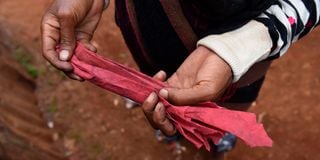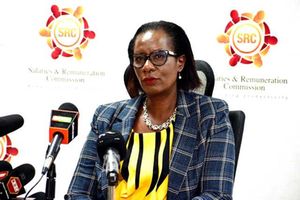Why millions of girls, women continue to suffer from period poverty

A woman holds a piece of cloth she uses as a sanitary pad on October 18, 2022 Some women opt to use such products for lack of money to buy the pads.
What you need to know:
- The UN agency notes that at least one in 10 women and girls in rural areas across 12 countries did not have a private place to wash and change during their last periods.
- In Bangladesh, Egypt, India, Madagascar and Zimbabwe, for example, adolescent girls and women in urban areas are more likely to use sanitary pads than those in rural areas.
Rose Achieng'* is a teenage girl living in the sprawling Kibera slums. She shares with Nation.Africa some of the challenges she faces as an adolescent.
The 16-year-old from Lindi village at the heart of the sprawling Kibera in Nairobi notes lack of sanitary towels as one of the main problems that she encounters every month.
“My mother in many instances lacks the money to buy the sanitary towels for me. I am usually forced to seek assistance from Kirta Touch the Needy, a non-governmental organisation that provides sanitary towels to the needy girls in the slums. Whenever they do not have, I have to look for alternatives, including using old clothes,” she says.
Achieng’s predicament is not isolated. It mirrors those of millions of other girls across the world who are unable to afford menstrual products.
According to the latest survey by UN Women, millions of women and girls worldwide still cannot afford menstrual products or access water and sanitation facilities to manage their menstrual health and hygiene.
The survey lists stigma, high cost of menstrual products, and lack of water and sanitation facilities as some of the drivers of period poverty, which is also perpetuated by stigma and the lack of information and education as many girls and young women lack awareness and are unprepared for their periods.
More than 1.5 billion people still lack basic sanitation services, such as private toilets.
“Menstrual products are prohibitively expensive for millions of people worldwide. Gender-blind policies and tax laws on feminine products – are, in part, to blame, but such policy decisions go together with the stigma and taboo attached to menstruation,” the UN Women Survey reads.
The UN agency notes that at least one in 10 women and girls in rural areas across 12 countries did not have a private place to wash and change during their last periods.
In Bangladesh, Egypt, India, Madagascar and Zimbabwe, for example, adolescent girls and women in urban areas are more likely to use sanitary pads than those in rural areas, who are more likely to use cloth and sponges.
One in five adolescent girls and women in rural Ethiopia used no materials, compared with 1 in 20 in urban areas, according to World Health Organisation (WHO) and Unicef data.
In the United States, one in four teens and one in three adults struggle to afford period products, especially teenagers of colour and from lower-income households.
A 2020 survey by Plan International showed that three in 10 girls in the United Kingdom struggle to afford or access menstrual products and more than half of them used toilet paper instead.
In a recent UN Women's report from Gaza, more than 540,000 women and girls of reproductive age lack access to items to support their hygiene, health and dignity.
They are resorting to cloth or sponges because they cannot access menstrual products. UN Women estimates that 10 million disposable menstrual pads are needed each month to cover the needs and preserve the dignity of women and girls in Gaza.
The survey indicates that period poverty is also perpetuated by stigma and lack of information and education.
It also finds that policymakers and adults with decision-making power in schools and workplaces also lack comprehensive menstrual education.
*Identity changed to protect the teenager.





